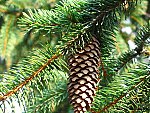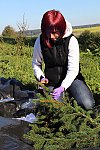Needles sampling
The MONAIRNET project also comprised collection of needle samples from Norway spruce trees (Picea abies) in addition to standard air sampling methods (active or passive sampling) and atmospheric deposition. Persistent organic pollutants (POPs) have low water solubility and a high n-octanol-water partition coefficient, and thus they tend to accumulate in lipid tissues, including the wax layer on plant surfaces. The wax layer of coniferous trees can collect and accumulate atmospheric POPs over long time periods and therefore can be used as plant passive air sampler. Monitoring air in vegetation is a cheaper and readily available method for estimating long-term atmospheric pollution in sites with a poor accessibility.
The needle sampling methodology used was the same as in the MONARPOP project. In October 2012, single-year needles were collected and analysed for selected POPs.
 |
 |

